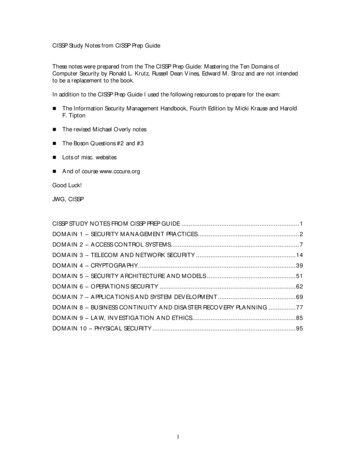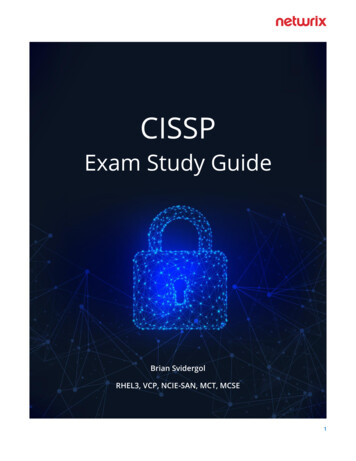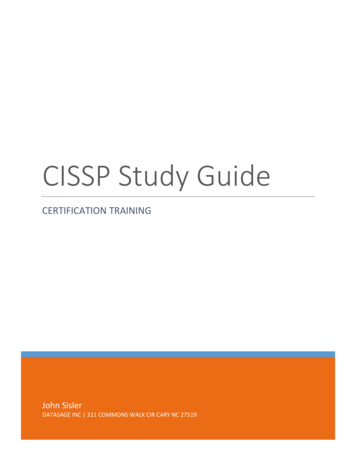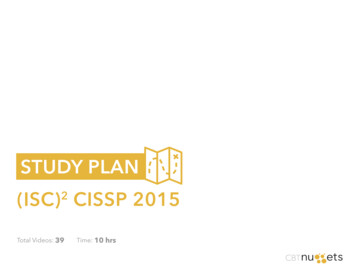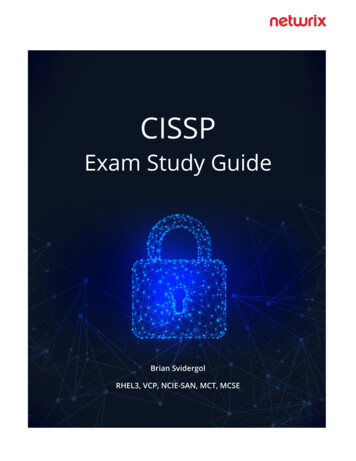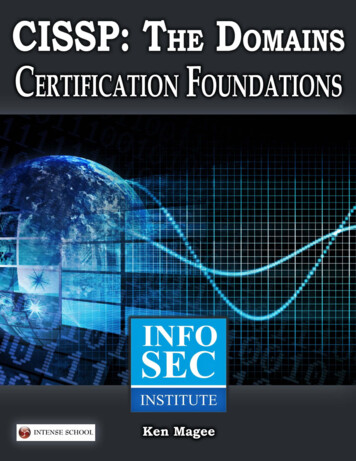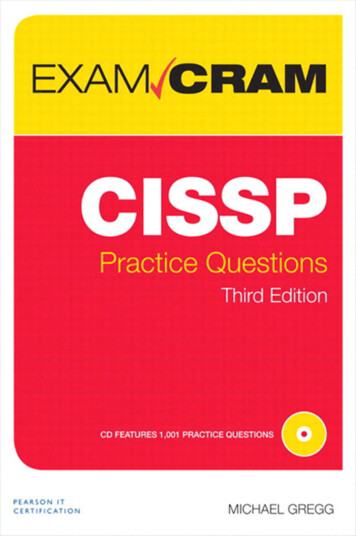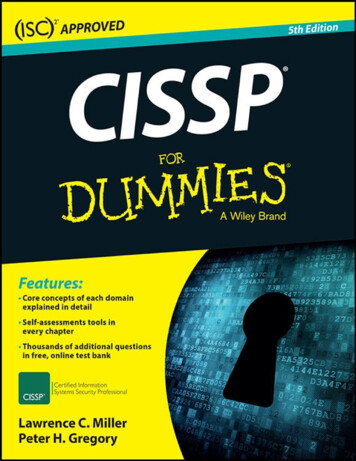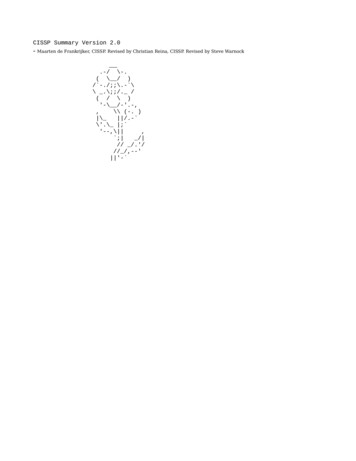
Transcription
CISSP Summary Version 2.0‐ Maarten de Frankrijker, CISSP. Revised by Christian Reina, CISSP. Revised by Steve Warnock.-/ \-.( \ / )/ -./;;\.- \\ .\;;/. /( / \ )'-\ /-'.-,,\\ (-. ) \ /.- \'.\ ; '--,\ , ; / // /.'/// /,--' '-
Domain 1: Security and Risk ManagementConcepts (10)CIADAD - NEGATIVE -(disclosure alteration and destruction)Confidentiality - prevent unauthorized disclosure, need to know, and least privilege. Assurance thatinformation is not disclosed to unauthorized programs, users, processes, encryption, logical andphysical access control,Integrity - no unauthorized modifications, consistent data, protecting data or a resource from beingaltered in an unauthorized fashionAvailability - reliable and timely, accessible, fault tolerance and recovery procedures, WHENNEEDEDIAAA - requirements for accountabilityIdentification - user claims identity, used for user access controlAuthentication - testing of evidence of users identityAccountability - determine actions to an individual personAuthorization - rights and permissions grantedPrivacy - level of confidentiality and privacy protectionRisk (12)Not possible to get rid of all risk.Get risk to acceptable/tolerable levelBaselines – minimum standardsISO 27005 – risk management frameworkBudget – if not constrained go for the Responsibilities of the ISO (15)Written Products – ensure they are done CIRT – implement and operate Security Awareness – provideleadership Communicate – risk to higher managementReport to as high a level as possible Security is everyone’s responsibility
Control Frameworks (17)Consistent – approach & applicationMeasurable – way to determine progressStandardized – all the sameComprehension – examine everythingModular – to help in review and adaptive. Layered, abstractionDue Care – Which means when a company did all that it could have reasonably done to try andprevent security breach / compromise / disaster, and took the necessary steps required ascountermeasures / controls (safeguards). The benefit of “due care” can be seen as the differencebetween the damage with or without “due care” safeguards in place. AKA doing something about thethreats, Failing to perform periodic security audits can result in the perception that due care is not beingmaintainedDue Diligence – means that the company properly investigated all of its possibly weaknesses andvulnerabilities AKA understanding the threatIntellectual property laws (24)Patent - grants ownership of an invention and provides enforcement for owner to exclude others frompracticing the invention. After 20 years the idea is open source of applicationCopyright - protects the expression of ideas but not necessarily the idea itself ex. Poem, song @70years after author diesTrade Secret - something that is propriety to a company and important for its survival and profitability(like formula of Coke or Pepsi) DON’T REGISTER – no applicationTrademarks - words, names, product shape, symbol, color or a combination used to identify productsand distinguish them from competitor products (McDonald’s M) @10 yearsWassenaar Arrangement (WA) – Dual use goods & trade, International cryptographic agreement,prevent destabilizingComputer Crimes – loss, image, penaltiesRegulationsSOX, Sarbanes Oxley, 2002 after ENRON and World Online debacle Independent review by externalaccountants.Section 302: CEO’s CFO’s can be sent to jail when information they sign is incorrect. CEO SIGN
Section 404 is the about internal controls assessment: describing logical controls over accountingfiles; good auditing and information security.Corporate Officer Liability (SOX)- Executives are now held liable if the organization they represent is not compliant with the law.Negligence occurs if there is a failure to implement recommended precautions, if there is nocontingency/disaster recovery plan, failure to conduct appropriate background checks, failure toinstitute appropriate information security measures, failure to follow policy or local laws andregulations.COSO – framework to work with Sarbanes-Oxley 404 complianceEuropean laws: TREADWAY COMMISSIONNeed for information security to protect the individual.Privacy is the keyword here! Only use information of individuals for what it was gathered for(remember ITSEC, the European version of TCSEC that came from the USA/Orange Book, cometogether in Common Criteria, but there still is some overlap) strong in anti-spam and legitimate marketingDirects public directories to be subjected to tight controlsTakes an OPT-IN approach to unsolicited commercial electronic communicationsUser may refuse cookies to be stored and user must be provided with informationMember states in the EU can make own laws e.g. retention of dataCOBIT - examines the effectiveness, efficiency, confidentiality, integrity, availability, compliance, andreliability of high level control objectives. Having controls, GRC heavy auditing, metrics, regulatedindustry.Data Breaches (27)Incident – an event that has potential to do harmBreach – incident that results in disclosure or potential disclosure of dataData Disclosure – unauthorized acquisition of personal informationEvent – Threat events are accidental and intentional exploitations of vulnerabilitiesLaws (28)ITAR, 1976. Defense goods, arms export control act
FERPA – EducationGLBA, Graham, Leach, Bliley; credit related PII (21)ECS, Electronic Communication Service (Europe); notice of breachesFourth Amendment - basis for privacy rights is the Fourth Amendment to the Constitution.1974 US Privacy Act - Protection of PII on federal databases1980 Organization for Economic Cooperation and Development (OECD) - Provides for datacollection, specifications, safeguards1986 (amended in 1996) US Computer Fraud and Abuse Act - Trafficking in computer passwords orinformation that causes a loss of 1,000 or more or could impair medical treatment.1986 Electronic Communications Privacy Act - Prohibits eavesdropping or interception w/odistinguishing private/publicCommunications Assistance for Law Enforcement Act (CALEA) of 1994 - amended the ElectronicCommunications Privacy Act of 1986. CALEA requires all communications carriers to make wiretapspossible for law enforcement with an appropriate court order, regardless of the technology in use.1987 US Computer Security Act - Security training, develop a security plan, and identify sensitivesystems on govt. agencies.1991 US Federal Sentencing Guidelines - Responsibility on senior management with fines up to 290million. Invoke prudent man rule. Address both individuals and organizations1996 US Economic and Protection of Propriety Information Act - industrial and corporateespionage1996 Health Insurance and Portability Accountability Act (HIPPA) – amended1996 US National Information Infrastructure Protection Act - Encourage other countries to adoptsimilar framework.Health Information Technology for Economic and Clinical Health Act of 2009 (HITECH) Congress amended HIPAA by passing this Act. This law updated many of HIPAA’s privacy andsecurity requirements. One of the changes is a change in the way the law treats business associates(BAs), organizations who handle PHI on behalf of a HIPAA covered entity. Any relationship between acovered entity and a BA must be govern ed by a written contract known as a business associateagreement (BAA). Under the new regulation, BAs are directly subject to HIPAA and HIPAAenforcement actions in the same manner as a covered entity. HITECH also introduced new data breachnotification requirement.
Ethics (33)Just because something is legal doesn’t make it right. Within the ISC context: Protecting informationthrough CIAISC2 Code of Ethics Canons Protect society, the commonwealth, and the infrastructure.Act honorably, honestly, justly, responsibly, and legally.Provide diligent and competent service to principals.Advance and protect the profession.Internet Advisory Board (IAB)Ethics and Internet ( 1087)Don’t compromise the privacy of users. Access to and use of Internet is a privilege and should betreated as such It is defined as unacceptable and unethical if you, for example, gain unauthorized accessto resources on the internet, destroy integrity, waste resources or compromise privacyBusiness Continuity plans development (38) Defining the continuity strategy Computing strategy to preserve the elements of HW/SW/ communication lines/data/application Facilities: use of main buildings or any remote facilitiesPeople: operators, management, technical support personsSupplies and equipment: paper, forms HVACDocumenting the continuity strategyBIA (39)Goal: to create a document to be used to help understand what impact a disruptive event would haveon the businessGathering assessment material Org charts to determine functional relationships Examine business success factorsVulnerability assessment Identify Critical IT resources out of critical processes, Identify disruption impacts andMaximum, Tolerable Downtime (MTD)
Loss Quantitative (revenue, expenses for repair) or Qualitative (competitive edge, publicembarrassment). Presented as low, high, medium. Develop recovery proceduresAnalyze the compiled information Document the process Identify inter-dependability Determine acceptable interruption periodsDocumentation and RecommendationRTO MTDAdministrative Management Controls (47)Separation of duties - assigns parts of tasks to different individuals thus no single person has totalcontrol of the system’s security mechanisms; prevent collusionM of N Control - requires that a minimum number of agents (M) out of the total number of agents (N)work together to perform high-security tasks. So, implementing three of eight controls would requirethree people out of the eight with the assigned work task of key escrow recovery agent to work togetherto pull a single key out of the key escrow databaseLeast privilege - a system’s user should have the lowest level of rights and privileges necessary toperform their work and should only have them for the shortest time. Three types: Read only, Read/writeand Access/changeTwo-man control - two persons review and approve the work of each other, for very sensitiveoperationsDual control - two persons are needed to complete a taskRotation of duties - limiting the amount of time a person is assigned to perform a security related taskbefore being moved to different task to prevent fraud; reduce collusionMandatory vacations - prevent fraud and allowing investigations, one week minimum; kill processesNeed to know - the subject is given only the amount of information required to perform an assignedtask, business justificationAgreements – NDA, no compete, acceptable useEmployment (48)staff members pose more threat than external actors, loss of money stolen equipment, loss of time workhours, loss of reputation declining trusts and loss of resources, bandwidth theft, due diligence
Voluntary & involuntary - Exit interview!!Third Party Controls (49) Vendors Consultants ContractorsProperly supervised, rights based on policyRisk Management Concepts (52)Threat – damage Vulnerability – weakness to threat vector (never does anything) Likelihood –chance it will happen Impact – overall effects Residual Risk – amount left over Organizations ownthe risk Risk is determined as a byproduct of likelihood and impactITIL (55)ITIL – best practices for IT core operational processes, not for audit ServiceChangeReleaseConfigurationStrong end to end customer focus/expertiseAbout services and service strategyRisk Management (52)GOAL - Determine impact of the threat and risk of threat occurringThe primary goal of risk management is to reduce risk to an acceptable level.Step 1 – Prepare for Assessment (purpose, scope, etc.)Step 2 – Conduct Assessment ID threat sources and eventsID vulnerabilities and predisposing conditionsDetermine likelihood of occurrenceDetermine magnitude of impactDetermine risk
Step 3 – Communicate Risk/resultsStep 4 – Maintain Assessment/regularlyTypes of RiskInherent chance of making an error with no controls in placeControl chance that controls in place will prevent, detect or control errorsDetection chance that auditors won’t find an errorResidual risk remaining after control in placeBusiness concerns about effects of unforeseen circumstancesOverall combination of all risks aka Audit riskPreliminary Security Examination (PSE): Helps to gather the elements that you will need when theactual Risk Analysis takes place.ANALYSIS Steps: Identify assets, identify threats, and calculate risk.ISO 27005 – deals with riskRisk Assessment Steps (60)Four major steps in Risk assessment?Prepare, Perform, Communicate, MaintainQualitative (57)Approval – Form Team – Analyze Data – Calculate Risk – Countermeasure Recommendations REMEMBER HYBRIDQuantitative Risk Analysis (58) Quantitative VALUES!! SLE (single Loss Expectancy) Asset Value * Exposure factor (% loss of asset) ALE (Annual loss expectancy) SLE * ARO (Annualized Rate of occurrence)Accept, mitigate(reduce by implementing controls calculate costs-),Assign (insure the risk to transfer it), Avoid (stop business activity)Loss probability * cost
Residual risk - where cost of applying extra countermeasures is more than the estimated loss resultingfrom a threat or vulnerability (C L). Legally the remaining residual risk is not counted when decidingwhether a company is liable.Controls gap - is the amount of risk that is reduced by implementing safeguards. A formula forresidual risk is as follows: total risk – controls gap residual riskRTO – how quickly you need to have that application’s information available after downtime hasoccurredRPO - Recovery Point Objective: Point in time that application data must be recovered to resumebusiness functions; AMOUNT OF DATA YOUR WILLING TO LOSEMTD - Maximum Tolerable Downtime: Maximum delay a business can be down and still remainviable * MTD minutes to hours: critical * MTD 24 hours: urgen
Domain 1: Security and Risk Management Concepts (10) CIA DAD - NEGATIVE -(disclosure alteration and destruction) Confidentiality - prevent unauthorized disclosure, need to know, and least privilege. Assurance that information is not disclosed to unauthorized programs,

